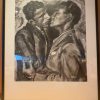Both gay men and heterosexual men prefer masculine-presenting men for high-status roles, according to a new study from the University of Sydney, leaving more feminine-presenting gay men disadvantaged and facing internal bias, prejudice and potential discrimination in the workplace, including in hiring practices and promotion opportunities.
The research published in the journal Sex Roles is believed to be the first experimental study to demonstrate status costs for gay men who present with more feminine than masculine qualities across workplace hierarchies. It also demonstrates implicit bias among gay men as a community.
Ben Gerrard is a researcher in gender and sexuality in the School of Psychology at the University of Sydney. He defines feminine-presenting traits as more feminine, as traditionally understood/defined vocal quality, body language and posture.
Gerrard says the finding that gay men prefer a more “straight-acting” gay man for high-status roles is disappointing and potentially creating a gay glass ceiling in workplaces.
“Gay men are potentially blocking each other from positions of power and leadership due to this implicit bias,” he said. “Men are still expected to conform to more traditional masculine styles of leadership and if they fail to sufficiently project masculine traits they are at risk of status penalites. This is an example of internalised homophobia among the gay community and it impacts opportunities for these gay men.”
Gerrard said while gay men appear to enjoy increasing equality and representation in Western cultures, they are still disadvantaged in pursuing high-status opportunities, compared to heterosexual men. “The findings point to the need for advocacy and training to counter apparent bias against feminine-presenting gay men in a range of professional contexts and populations,” he said.
Testing internal biases against sexuality and gender traits
The researcher created a mock TV commercial casting brief for a campaign promoting tourism in Sydney. The mock campaign aimed to sell Sydney overseas and the casting called for an actor who could be viewed as a leader or someone who would be admired by the audience.
The researcher, (himself a professional actor) created videos of six shortlisted ‘candidates’ using professional actors, all gay men in real-life, who acted the same script in both a feminine-gay and masculine-gay manner (manipulating their voice, mannerisms, and posture but otherwise everything else was kept identical).
A survey of 256 gay and heterosexual men were invited to watch the videos and to look for an actor who could be seen as a “leader” who could represent Australia. They viewed the feminine or masculine version of a particular actor, and placed casting preferences for the role. The researcher found that both gay men and heterosexual men preferred the more masculine-gay male actor for the advert (discriminating against the feminine-gay actor).
Heterosexual men higher in homonegativity and gay men higher in misogyny both showed a stronger preference for the masculine-gay actor over the feminine-gay actor. These findings hold important implications for implicit bias and hiring practices.
Need for greater acceptance
More work is required to challenge the prevailing association between masculinity and high status, Gerrard says, especially in light of contemporary leadership theories, which suggest traits, traditionally perceived as ‘feminine’, such as warmth, can be more effective in managing modern workplaces.
“We operate in teams-based workplaces now where effective leadership qualities – warmth, empathy and good communication – are all considered feminine traits, and a more feminine-presenting gay man might be an ideal candidate for a leadership role,” Gerrard said. “And yet we still value traditional masculinity at a senior leadership level as a measure of the capacity to lead, because traditional feminine traits are considered too soft or not authoritative enough.”
“This homophobic bias is putting pressure on feminine-presenting gay men to conform so they might be passable as a heterosexual man,” Gerrard said. “What we need is an increase in authentic representation of empowered feminine-presenting gay men – especially in the media: in order to counter misinformed biases regarding their ability to lead. There needs to be education and awareness within the community and in recruitment processes – around the potential to be unconsciously influenced by these unfair biases.”

































































